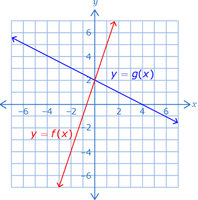You are using an out of date browser. It may not display this or other websites correctly.
You should upgrade or use an alternative browser.
You should upgrade or use an alternative browser.
help determining an equation for g(x) in terms of f(x). (Transformations)
- Thread starter Madtemper
- Start date
D
Deleted member 4993
Guest
Did you post the COMPLETE problem EXACTLY?View attachment 25174
I have been having a difficult time trying to find the equation for g(x). I had picked out a few points from both functions, but the transformations were not apparent to me. Some guidance/help would be great!
Steven G
Elite Member
- Joined
- Dec 30, 2014
- Messages
- 14,561
g(x) has a slope of -1/2 and a y-intercept of 2. At this point you can just write down the equation of g(x).
f(x) has a slope of -3 and a y-intercept of 2. At this point you can just write down the equation of f(x).
Can you please do that and we can go from there.
f(x) has a slope of -3 and a y-intercept of 2. At this point you can just write down the equation of f(x).
Can you please do that and we can go from there.
Yes, I figured the equation for f(x) is y=3x+2. I guess in terms of just y=x, the equation for g(x) is y=-1/2x+2 but I assumed that this equation is irrelevant as it is not in terms of f(x).g(x) has a slope of -1/2 and a y-intercept of 2. At this point you can just write down the equation of g(x).
f(x) has a slope of -3 and a y-intercept of 2. At this point you can just write down the equation of f(x).
Can you please do that and we can go from there.
Last edited:
D
Deleted member 4993
Guest
g(x) = -1/2 * x +2 = -1/6 *(3*x +2) + 7/3 = - f(x) * 1/6 +7/3..........correctedYes, I figured the equation for f(x) is y=3x+2. I guess in terms of just y=x, the equation for g(x) is y=-1/2x+2 but I assumed that this equation is irrelevant as it is not in terms of f(x).
Last edited by a moderator:
Could you please elaborate and clarify a bit on what you had done? Where did the -1/6 and 5/3 come from?g(x) = -1/2 * x +2 = -1/6 *(3*x +2) + 5/3 = - f(x) * 1/6 +5/3
Thanks!
Dr.Peterson
Elite Member
- Joined
- Nov 12, 2017
- Messages
- 16,618
Assuming you're supposed to use transformations to do this (which does seem unnatural, since you can just find the equations of both functions), you might look at their slopes and use their ratio as your vertical stretch factor (which will technically include a reflection). Then you might first shift f by an appropriate amount so that the two lines intersect on the x-axis, and then apply the stretch you worked out. Those two transformations should to it. But there will be many other ways as well.View attachment 25174
I have been having a difficult time trying to find the equation for g(x). I had picked out a few points from both functions, but the transformations were not apparent to me. Some guidance/help would be great!
Steven G
Elite Member
- Joined
- Dec 30, 2014
- Messages
- 14,561
Now YOU have to write g(x) in terms of f(x)Yes, I figured the equation for f(x) is y=3x+2. I guess in terms of just y=x, the equation for g(x) is y=-1/2x+2 but I assumed that this equation is irrelevant as it is not in terms of f(x).
For example, suppose it turned out that g(x) = 4x+6. YOU need to realize that g(x) = 4x+6 = 2(x+3) = 2f(x). Is this clear? No matter what g(x) turned out to be it would NOT have f(x) in it unless you put there after seeing what g(x) equaled.
Also, where did y=x come from?????
Steven G
Elite Member
- Joined
- Dec 30, 2014
- Messages
- 14,561
g(x) = -1/2 * x +2 = -1/6 *(3*x +2) + 5/3 = - f(x) * 1/6 +5/3
Could you please elaborate and clarify a bit on what you had done? Where did the -1/6 and 5/3 come from?
Thanks!
What constant would you multiply 3x by to get -1/2 x? Answer -1/6. Now -1/6(3x+2) = -1/2x - 1/3. So you have the -1/2x which is good. Now you need the constant to be 2. The constant right now is -1/3. Well what do you add to -1/3 to get to 2? Hint: The answer is not 5/3 as Subhotosh said.
Steven G
Elite Member
- Joined
- Dec 30, 2014
- Messages
- 14,561
Corner time for 5/3 of a year.g(x) = -1/2 * x +2 = -1/6 *(3*x +2) + 5/3 = - f(x) * 1/6 +5/3
You would add 2.333... to -1/3 to get to 2.What constant would you multiply 3x by to get -1/2 x? Answer -1/6. Now -1/6(3x+2) = -1/2x - 1/3. So you have the -1/2x which is good. Now you need the constant to be 2. The constant right now is -1/3. Well what do you add to -1/3 to get to 2? Hint: The answer is not 5/3 as Subhotosh said.
D
Deleted member 4993
Guest
Write 2.333..... in fraction form.
You would add 2.333... to -1/3 to get to 2.

